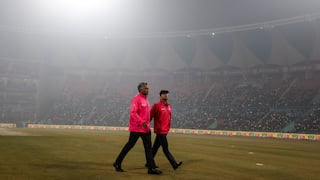Chandrayaan-3 Moon Landing's '15 Minutes Of Terror' To Involve Critical Manoeuvres. All About The Phases Of Descent
The phases of descent are initial preparation, velocity reduction, orientation change, attitude hold phase, fine braking, final descent, and touchdown, a former scientist at ISRO told ABP Live.

Chandrayaan-3 is expected to make a historic touchdown on the Moon on August 23, 2023, at around 6:04 pm IST, making India the first country to softly land a spacecraft on the lunar south pole. The period before touchdown is critical, and involves complex manoeuvres. The last 15 minutes before Chandrayaan-3's Moon landing are known as the '15 minutes of terror'. The phases of descent are initial preparation, velocity reduction, orientation change, attitude hold phase, fine braking, final descent, and touchdown, a former scientist at the Indian Space Research Organisation (ISRO) told ABP Live. After Chandrayaan-3's Vikram lander and Pragyan rover land on the Moon, images captured by the cameras onboard the spacecraft will be shared with Earth.
"The crucial moments during the last 15 minutes before touchdown encapsulate intricate manoeuvres, intense calculations, and an unwavering commitment to exploring the Moon's mysteries," said Manish Purohit, a former ISRO scientist who was involved in the Chandrayaan-2 and Mangalyaan projects.
Chandrayaan-3’s ‘15 minutes of terror’ before lunar touchdown
The initial preparation phase comprises the final 1,139 seconds of the Chandrayaan-3 mission, and it is during this stage that the most critical operations will be performed.
"When the final descent begins, the Vikram lander will be positioned about 750 kilometres from the landing site, will soar 25 to 30 kilometres above the lunar surface, and race at a velocity of about 1,600 metres per second horizontally," said Purohit.
The next phase, which is velocity reduction, will last 690 seconds, and thrusters will be fired to reduce Vikram's velocity to one-fourth of its initial speed, said Purohit. "With this controlled slowdown and the Moon's gravitational pull, the Vikram lander will start descending vertically at around 60 metres per second."
The orientation change phase will take place simultaneously with the velocity reduction stage. During the orientation change phase, the lander will be slightly rotated, and a crucial calibration will be conducted 32 kilometres from the landing site, and 7.5 kilometres above the ground, Purohit explained.
The attitude hold phase is a sensitive stage, and will last 10 seconds, said Purohit. "It will check the terrain and confirm the landing spot, avoiding the complications that caused Chandrayaan-2 to crash on the Moon."
During the critical fine braking phase, Vikram will be aligned vertically, and will hover at a height of 800 to 1,300 metres above the landing site, said Purohit. "Cameras and sensors will be activated, the computer onboard the spacecraft will process information, and decisions about landing will be finalised."
The final descent phase is the one in which the Vikram lander will hover above the lunar surface at a distance of around 150 metres. "The hazard detection camera's 'Go/No-Go' checks will guide the final decision. If all is well, Vikram will commit to the 73-second descent that will mark its historic touchdown," Purohit explained.
The historic touchdown
Once the Vikram lander successfully lands on the lunar south pole, the sensors will signal the computer onboard the spacecraft. After this, the lander will be powered up completely, and Vikram will unfurl the rover ramp so that the Pragyan rover can embark on its lunar journey.
The enhanced communication network, facilitated by the Chandrayaan-2 orbiter, the Chandrayaan-3 propulsion module, and ISRO's Deep Space Network Antenna will allow the images captured by cameras onboard Vikram and Pragyan to be shared with Earth, and other data to be transmitted to mission control stations.
"Following successful health checks, ISRO will carry out experiments to study lunar soil and plasma, offering insights on lunar mysteries to the global scientific community. These endeavours pave the way for future lunar exploration and potential human habitation," Purohit concluded.
Chandrayaan-3's lunar landing may be delayed: ISRO scientist
While Chandrayaan-3 is expected to touch down on the lunar surface on August 23, the landing may be delayed by “three to four days” if conditions are unfavourable, a senior scientist at ISRO told ABP Live. If the landing is delayed, the scientist added, Chandrayaan-3 may operate on the Moon for about 10 days, instead of 14 Earth days. This means that if Chandrayaan-3's landing is delayed, the spacecraft may touch down on the lunar south pole on August 26 or 27. He explained that Chandrayaan-3 carries sufficient fuel to allow delays in landing in case conditions are not favourable.
"Landing on the designated date is not the priority, safe landing is. What happened to Luna 25? That's the best example. If you have safe manoeuvre and landing, the world will still be yours," said K. Siddhartha, Earth Scientist at ISRO and a strategic thinker.
MUST READ | Chandrayaan-3 Landing Could Be Delayed By '3-4 Days' If Conditions Are Unfavourable
However, he said that a very complex manoeuvre will be involved during the landing of Chandrayaan-3. “The manoeuvring will become very complex with any delay.”
Siddhartha explained that the tilt and the thrust are important. "So, if you apply a force greater than the amount required, Chandrayaan-3 might get toppled. If you apply a small amount of force, there is a danger of Chandrayaan-3 hitting the lunar surface at the wrong place. Chandrayaan-3 will be landing somewhere between Manzinus C and Simpelius N craters.”
ALSO READ | Why Chandrayaan-2's Vikram Lander Crashed, And What Changes ISRO Has Made To Ensure Chandrayaan-3's Success
Not only will a successful landing of Chandrayaan-3 on the lunar south pole mark a historic moment for India, but will also allow the spacecraft to perform experiments on the ice and explore how these reserves could be used to extract water, oxygen and fuel for future crewed missions to the Moon.
Since the lunar south pole is similar to Earth’s diversity, exploring it will allow scientists to obtain insights into how the Earth was billions of years ago, and if it will be possible to colonise the Moon in the future.
MUST READ | Why Is Chandrayaan-3 Aiming To Land On Moon's South Pole? It Represents Earth's Diversity, Say Experts







































